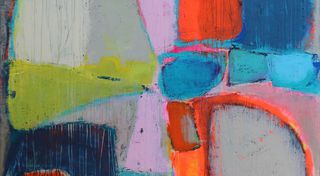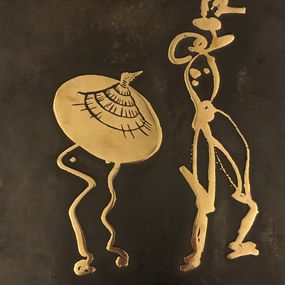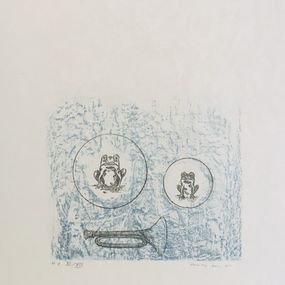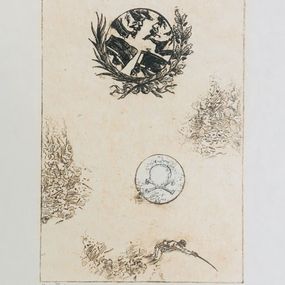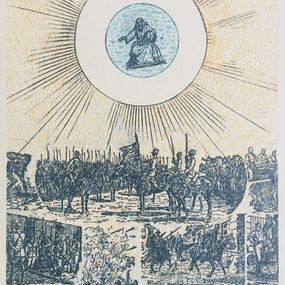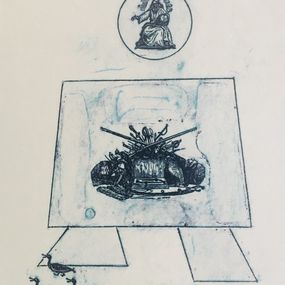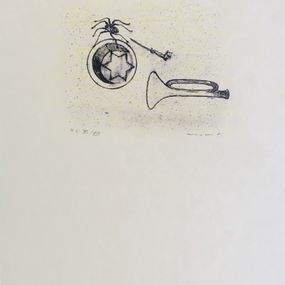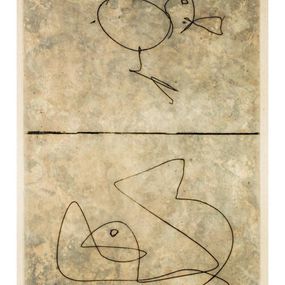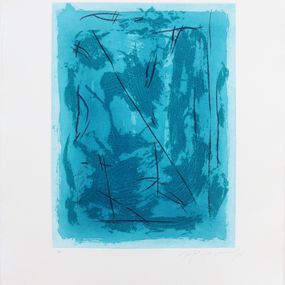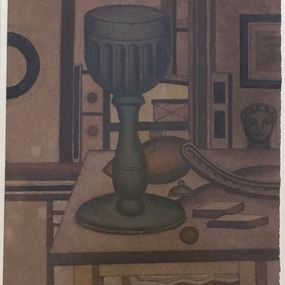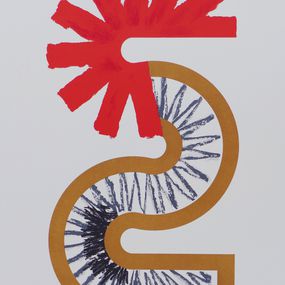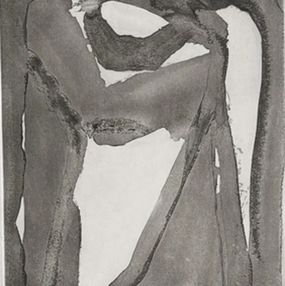
Sans titre 4,
1970
Max Ernst
Sculpture : metal, bronze patina, fashion accessory, brass
30 x 28 x 2 cm 11.8 x 11 x 0.8 inch
Free returns within 14 days
Authenticity guaranteed
Learn moreSecure payment
About the artwork
Type
Numbered and limited to 12 copies
Signature
Signed artwork
Authenticity
Sold with certificate of Authenticity from the gallery
Invoice from the gallery
Dimensions cm • inch
30 x 28 x 2 cm 11.8 x 11 x 0.8 inch Height x Width x Depth
Tags
Artwork sold in perfect condition
Artwork location: France
Edition of 12
Mint contidition
Discover more by the artist
Presentation
Max Ernst is a German painter and sculptor born in 1891 in Brühl and who died in 1976 in Paris. The son of painter Philipp Ernst, he began studying philosophy at the University of Bonn in 1909, but quickly abandoned this in order to devote himself to art. In 1911, Ernst met the members of the Blaue Reiter group with whom he exhibited two years later.
Between 1909 and 1913, his early paintings were inspired by expressionism, then later became more surreal. In 1913, he left for Paris and met Guillaume Apollinaire and Robert Delaunay. The First World War then spread through Europe and Max Ernst found a common desire for protest among his colleagues in the Dada movement. He then actively participated in the Dada movement in Cologne, which became an important centre for the movement. Paul Klee and Marcel Duchamp were marked influences on his works at this time.
In 1929, Max Ernst discovered De Chirico's metaphysical painting, and became Paul Eluard's friend in 1921. He then explored dream painting in a fantastically realist style. In 1925, he invented the technique of 'frottage' (rubbing), where he would let his pencil move over a piece of paper placed on various surfaces, allowing mysterious patterns to appear at random. Over the course of his many travels, he also made collages and later tried his hand at sculpture.
In 1945, Max Ernst fled from Europe to New York where he continued his art with Marc Chagall and Marcel Duchamp while also contributing to the birth of abstract expressionism. However, he returned to France in the 1950s and after receiving a prize at the Venice Biennale, he was excluded from the surrealist movement. The Max Ernst Museum with 300 of his works opened in Brühl in 2005 and many exhibitions are dedicated to him, notably in Paris.
More works from Galerie Hus
Artsper delivers internationally. The list of countries is available in the first step of your cart.
If your country is not listed contact us at [email protected] and we will see what we can do.
Note that Customs fees may apply for works shipped internationally. This is indicated in the first step of the shopping cart.
You can choose a delivery address different from the billing address. Make sure that a trusted person is present to receive the work if you cannot be there.
Have you purchased a painting, sculpture or work on paper?
Find our expert advice for the conservation and promotion of your works in the articles below:
Artsper offers you access to more than 200,000 works of contemporary art from 2,000 partner galleries. Our team of experts carefully selects galleries to guarantee the quality and originality of the works.
You benefit from:
-
Works at gallery price
-
Return within 14 days, regardless of your location
-
Easy resale of the work purchased on Artsper
-
Personalized research tools (selection and tailor-made universe)
Our customer service is available for any assistance.
At Artsper, our mission is to allow you to collect works of art with complete peace of mind. Discover the protections we offer at every stage of your shopping experience.
Buy works from top galleries
We work in close collaboration with carefully selected art galleries. Each seller on Artsper is carefully examined and approved by our team, thus ensuring compliance with our code of ethics. You therefore have the assurance of purchasing authentic, high-quality works.
Total transparency: you know what you are buying
Before being posted online, all artwork on Artsper is reviewed and validated by our moderation team. You can browse with complete peace of mind, knowing that each piece meets our criteria of excellence.
Personalized support: our experts at your service
Our team of contemporary art experts is available by phone or email to answer all your questions. Whether you want advice on a work or a tailor-made selection to enrich your collection, we are here to support you.
Resell your works with ease
If you have purchased a work on Artsper and wish to resell it, we offer you a dedicated platform to relist it. To find out more, click here.
Make offers with Artsper: negotiate like in a gallery
You have the possibility to propose a price for certain works, just like in a gallery. This feature allows you to initiate discussions and potentially acquire your coins at advantageous prices.
Get help with your negotiations
Our team will negotiate for you and inform you as soon as the best offer is obtained. Do not hesitate to call on our expertise to ensure a transaction at the best price.
Order securely
Artsper satisfaction assurance
We want you to be completely satisfied with your purchase. If the work you receive is not to your liking, you have 14 days to return it free of charge, and you will be refunded in full, whatever the reason.
Secure payment with Artsper partners
All credit card payments are processed by Paybox, the world leader in payment solutions. Thanks to their strict security standards, you can transact with confidence.
Problem Support
In the rare event that an artwork arrives damaged or not as described, we are here to help. Whether for a return, refund, restoration or exchange, our team will support you throughout the process and will ensure that we find the solution best suited to your situation.
Conditions to benefit from Artsper protections:
-
Use one of the payment methods available on Artsper for your order.
-
Report any problems within one week of receiving the work.
-
Provide required photographic evidence (including original artwork and packaging).
Artsper guarantees cover the following cases:
-
The received work lacks a described characteristic (for example, a signature or frame).
-
The artwork has significant differences from its description (e.g. color variation).
-
The work is damaged upon receipt.
-
The work is lost or damaged by the carrier.
-
Delivery is significantly delayed.
With Artsper, you collect with complete peace of mind.
